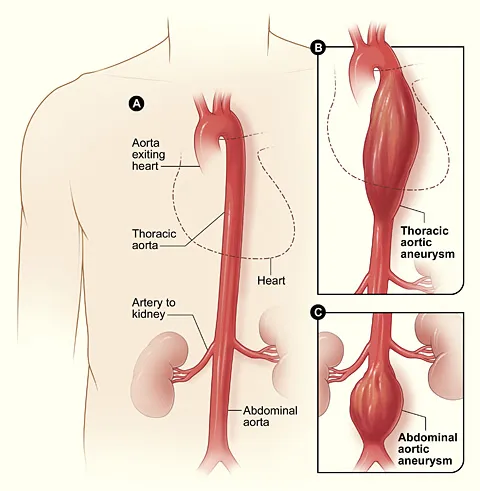An abdominal Aortic Aneurysm (AAA) is an abnormal bulging of an artery in the abdomen area. It is Caused by the weakening of the Aortic wall, typically due to age-related conditions such as hypertension, atherosclerosis, or trauma.
One in every 25 people over the age of 65 has AAA.
It can lead to life-threatening complications if not treated quickly and adequately.
Even those who do not experience rupture may be at risk for internal bleeding, stroke, or other severe side effects. It is important to diagnose and treat AAA as soon as possible to reduce its prevalence and severity.

Symptoms
Abdominal Aortic Aneurysm (AAA) can be difficult to detect, as it is often symptomless. Some patients may experience symptoms such as a pulsing sensation in their abdomen or flank area, persistent abdominal or back pain, and a feeling of fullness in the abdomen.
In some cases, nausea, fever, or vomiting can occur.
However, these symptoms are not exclusive to AAA (Abdominal Aortic Aneurysm) and may indicate other conditions.
As AAA can be silent but life-threatening, people over 65 must get ultrasound screenings regularly to detect any aneurysms quickly and take preventative action when necessary.
Causes and Risk Factors
Abdominal Aortic Aneurysm (AAA) can be Caused by hypertension, atherosclerosis, or Trauma. It is often age-related and is more common in people over 65. Although it can affect both genders, it is more likely to occur in men.
Smoking and high blood pressure are considered risk factors for AAA and a family history of aneurysms or aortic disease. Regular screenings are important for patients in these risk groups to ensure early detection and proper treatment.
Diagnosis
If an AAA is suspected, imaging tests such as an ultrasound, CT scan, or MRI may be used to confirm the diagnosis. Further diagnostic procedures such as angiography or an arteriogram may be needed to diagnose AAA and assess its size and location.
A blood pressure cuff test can also help diagnose the condition. Regular screenings are recommended for people belonging to higher-risk groups to ensure early detection and proper treatment.
Treatment
Non-surgical treatments for Abdominal Aortic Aneurysms (AAA) involve lifestyle changes such as quitting smoking, losing weight, and controlling cholesterol levels.
For surgical treatment, an open or endovascular repair can be used depending on the size and location of the aneurysm. Each procedure carries its risks and benefits, and a doctor will determine which is most appropriate based on the patient's medical history, age, and overall health condition.
Open repair
Open repair is usually recommended if the aneurysm has grown to more than 5 cm in diameter, while the endovascular repair is suitable for smaller aneurysms.
Open repair has the advantage of allowing for the direct repair of complex aneurysms. However, it also carries a greater risk of mortality and morbidity than endovascular repair.
Endovascular repair
Endovascular repair is a less invasive procedure with fewer risks but can be limited in its ability to treat some conditions due to anatomical constraints.
In addition, endovascular repairs may require further surgeries to ensure the aneurysm does not recur. Both treatments have advantages and disadvantages, and every patient should discuss their options thoroughly with their doctor before deciding.
How does the cardiologist determine which treatment is appropriate?
A doctor's decision regarding which treatment a patient should undergo will depend on various factors such as medical history, age, health condition, aneurysm size and location, and other patient-specific information.
Generally speaking, open repair may be recommended if the aneurysm is more than 5 cm in diameter or if the patient has underlying conditions that make open repair preferable.
On the other hand, endovascular repair may be advised if the aneurysm is smaller in size or if a less invasive procedure would benefit the patient.
Before making their decision, the heart specialist may also consider other factors, such as the risk of recurrence after treatment and possible complications associated with each procedure.
Ultimately, it is up to the physician to decide which option is most suitable for each patient based on their unique needs.
Recovery and Aftercare
Recovery time and aftercare vary depending on the type of treatment a patient receives and their medical condition.
For open repair, patients may need to stay in the hospital for up to two weeks following surgery and may require additional therapy or rehabilitation afterwards.
Endovascular repair does not require an extended hospital stay but may still require follow-up appointments with the doctor.
Both treatments will likely require lifestyle changes such as quitting smoking and maintaining a healthy weight, as well as normal blood pressure and lipid screenings.
Long-term care
Long-term care depends on the patient's condition and overall health status. Generally, patients who have undergone open repair should follow up with their doctor once every year for a few years following surgery to monitor any changes in their condition or aneurysm size.
Patients undergoing endovascular repair should also receive regular checkups and tests over several years to detect any potential aneurysm recurrence.
In addition, some patients may need to take medications indefinitely to control their cholesterol levels or other risk factors associated with AAA. All postoperative care plans should be thoroughly discussed between the patient and their doctor before treatment.
Prevention
An aneurysm can be prevented in several ways. The most effective is to quit smoking if you currently smoke, as this increases the risk of developing an aneurysm. In addition, managing blood pressure and maintaining a healthy weight are also important steps to prevent AAA development.
Eating foods low in sodium and cholesterol, exercising regularly, and drinking alcohol moderately can all help to reduce the risk of an aneurysm forming. Finally, yearly checkups with a doctor can help detect any changes early and minimize the risk of developing a serious condition.
Although AAA is a serious condition, some steps can be taken to prevent its onset. Quitting smoking, managing blood pressure, maintaining a healthy weight and diet, and regularly seeing a doctor for checkups can all help reduce your risk of developing an aneurysm.
Suppose you experience any symptoms of AAA or have concerns about your vascular health. In that case, we encourage you to contact our team and schedule an appointment with one of our specialists to discuss further tests and possible treatments available.


